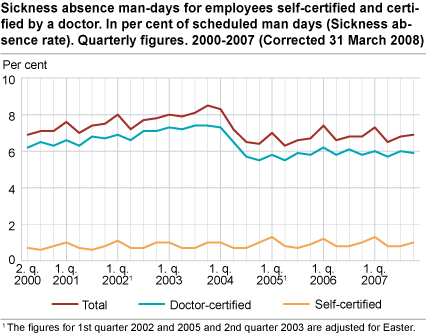Content
Published:
This is an archived release.
Slight increase in sickness absence
The sickness absence rose from 6.8 per cent in the fourth quarter of 2006 to 6.9 per cent in the fourth quarter of 2007, an increase of 1.6 per cent.
The sickness absence for men increased from 5.4 to 5.5 per cent, and for women from 8.6 to 8.7 per cent, a growth of 0.8 and 2.1 per cent respectively.
The sickness absence in the fourth quarter of 2007 was 7.6 per cent lower than in the fourth quarter of 2001, the year when the agreement on an inclusive labour market was implemented.
Small increase in most industries
Only two of the largest industries experienced a decline in sickness absence. The decline was 1.7 per cent in the construction industry and 0.4 per cent in the transport industry.
Public administration and education experienced a growth in sickness absence of 4.6 and 1.8 per cent respectively, but the level is still lower than the average for all industries.
Decreasing proportion of long-lasting absence
The proportion of doctor-certified sickness absence lasting more than 31 days fell from 60.7 per cent to 60.0 per cent from the fourth quarter of 2006 to the fourth quarter of 2007. As a proportion of the total sickness absence (self-certified and doctor-certified), the self-certified sickness absence rose from 14.1 per cent to 14.8 per cent.
Growth in all sectors
The sickness absence rose in both the private and public sector. The rise in central government (including health enterprises) was 3.3 per cent. Within this sector, the public administration industry had an increase of 8.3 per cent and the health care (mainly health enterprises) and education (universities and university colleges) industries both grew by 1.7 per cent.
Within local government, the increase was 2.5 per cent in public administration while education (primary and secondary education) and health care had an increase of 1.7 and 1.5 per cent respectively.
The sickness absence level was lowest in the private sector with 6.5 per cent and highest in local government with 8.7 per cent.
Strong increase in youngest age groups
With the exception of the oldest age groups, the doctor-certified sickness absence rose in all age groups. The 16-19 year-olds, which is a small group of employees, had a marked increase of 9.9 per cent. Amongst 20-24 and 25-29 year-olds, the increase in sickness absence was 4.8 and 2.8 per cent respectively. However, these age groups had a sickness absence level below the average.
With a decrease of 2.9 per cent, the sickness absence for 60-64 year-olds had the strongest decrease. In this group the sickness absence level was above average.
The results are based on data on sickness absence certified by a doctor, as the survey on self-certified absence does not contain data on sickness absence by age.
The sickness absence rate measures the proportion of scheduled man-days lost due to own sickness. The statistics do not cover self-employed persons.
Tables:
- Table 1 Sickness absence man-days for employees self-certified and certified by a doctor. In per cent of scheduled man-days (Sickness absence rate). Quarterly figures. 2000-2007
- Table 2 Sickness absence man-days for employees self-certified and certified by a doctor, by sex. In per cent of scheduled man-days (Sickness absence rate). Quarterly figures. 2000-2007
- Table 3 Sickness absence man-days for employees self-certified and certified by a doctor, by industry and type of sickness absence. In per cent of scheduled man days (Sickness absence rate). Quarterly figures. 2000-2007
- Table 28 Sickness absence by type of absence(self-certified or doctor-certified) and duration within the quarter
- Table 33 Change in per cent of the sickness absence rate for employees self-certified and certified by a doctor, by industry and type of sickness absence. Quarterly changes. 2000-2007
Tables
Contact
-
Arbeidsmarked og lønn
E-mail: arbeidsmarked@ssb.no
-
Unn H. Høydahl
E-mail: unnh.hoydahl@ssb.no
tel.: (+47) 40 90 23 77

